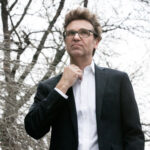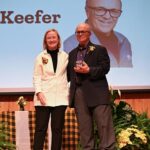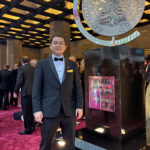
Stacey Lim ’01 has been breaking sound barriers throughout her life
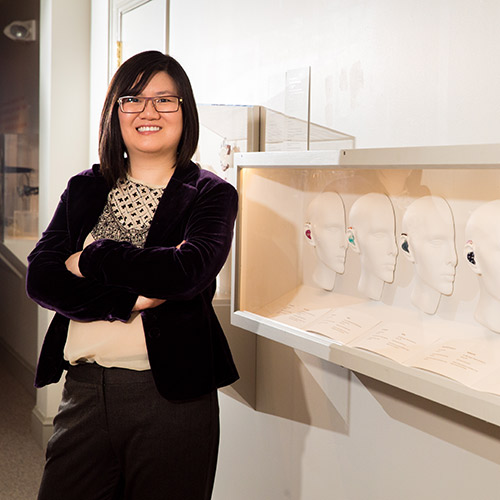
Stacey Lim ’01 never let being born profoundly deaf get in the way of living a full life. The 2001 communication sciences and disorders graduate of The College of Wooster earned a clinical doctorate in audiology and a Ph.D. in audiology, was a Fulbright scholar in Germany, and became a full-time faculty member at Central Michigan University 10 years ago. She also combined her passion for fashion and her research interest in rehabilitation into a museum exhibition and social media site called (dis)ABLED BEAUTY: the evolution of beauty, disability, and ability.
Lim had parents, health care providers, and educators who supported her along her journey from diagnosis to a career as a successful audiologist and communication sciences and disorders researcher and faculty member.
Donald Goldberg, communication sciences and disorders professor at Wooster, has been Lim’s advocate for more than 40 years and is now a research colleague. “I met Stacey after she was diagnosed when she was about one year old,” Goldberg recalled. “Then, she came to The College of Wooster one month after she got a cochlear implant. Now I have Wooster grads who go to Central Michigan, and I am doing research with this ‘kid’ that I’ve known since she was one.”
She was born in Akron Ohio, before newborn hearing screenings were mandatory. When Lim was about six weeks old, her mother noticed she wasn’t responding to sound. After multiple tests over the next several months, it was confirmed when Lim was about a year old that she was indeed profoundly deaf.
Her parents were distraught with the original diagnosis, but they learned a clinic in Denver might be able to help their daughter learn to speak and live a typical life. The family considered a move to Denver but then found out a similar facility was located next door in Pennsylvania.
Lim and her parents, an audiologist and speech-language pathologist traveled to meet with auditory-verbal therapy pioneer Helen Beebe, who believed most deaf children had a tiny bit of residual hearing. Though cochlear implants were not well developed at the time, Beebe de-emphasized the use of sign language and lip reading, and instead taught children how to hear, speak, and live typical lives with the help of hearing aids. Lim’s speech-language pathologist and audiologist learned from Beebe and returned to Ohio to use the methods with Lim and other children with profound deafness. Lim was the first auditory-verbal student in northeast Ohio.
Thanks to her parents who fought to mainstream their daughter, Lim joined regular classrooms in Stow, her home school district, in first grade. With supportive teachers and friends, she was active in Girl Scouts and other organizations.
She decided to become an audiologist during a conference in the Philippines when she was 15 years old. A physician on a panel commented that children who are born profoundly deaf would never learn to talk. “I was the one who had to speak after him. I said, ‘It IS possible. I’m here and I’m talking.’ That’s when I realized I wanted to be an audiologist to make sure parents knew all the options available,” Lim said.
Lim chose Wooster to pursue her communication sciences and disorders degree in part because of her longtime connection to Goldberg. “I knew Don was a really, really, good audiologist and auditory-verbal therapist. I wanted to learn from one of the best in the field,” she said. She also appreciated the welcoming, small-college atmosphere and the ability to get to know the faculty.
Just prior to coming to campus, Lim had a cochlear implant, which added a whole new dimension to her hearing experience. A long-time fan of musicals, the cochlear implant enhanced the little details of listening to music.
The education and experiences she received at Wooster prepared her for the next steps in her career journey. The hands-on clinical practicums in the Freedlander Speech and Hearing Clinic provided valuable experiences working with clients in both speech-language pathology and audiology. Not many undergraduate communication sciences and disorders programs offer clinical experiences beyond observations, Goldberg pointed out.
Before she pursued the audiology degree, she accepted the Fulbright Scholar award that combined her interest in audiology, minor in German Language and Literature, and seven years of German language classes. While in Germany, she perfected her German and researched the social, educational, and political support for people who were deaf or hard of hearing in Germany.
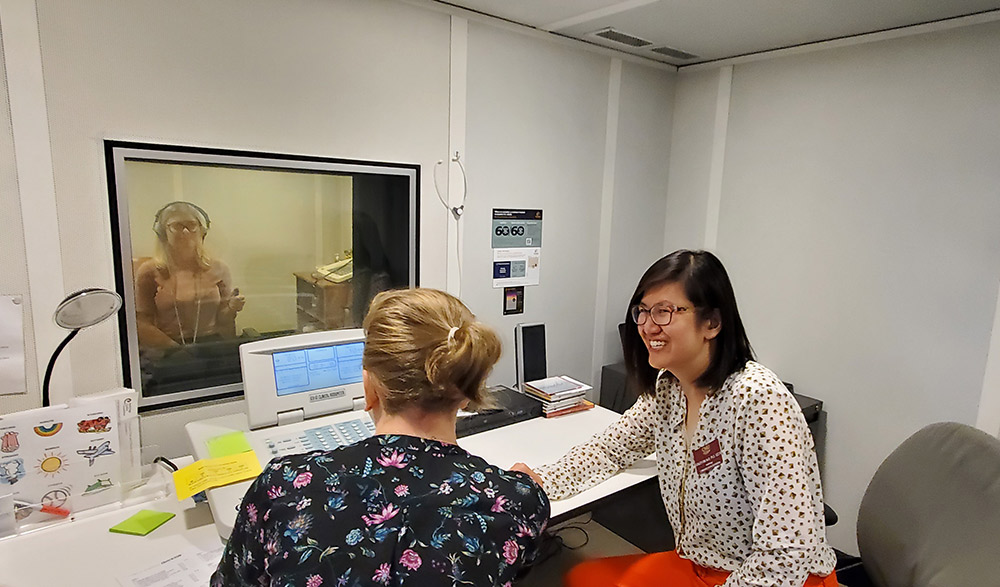
Stacey Lim sits in front of an audiometer to watch as one of her students tests another student’s hearing. Photo: Jana AI Jurdi
Lim continued her education, received her Au.D. from the Northeast Au.D. Consortium in 2006 and Ph.D. at Kent State University in 2013. At Central Michigan, she is associate professor of communication sciences and disorders, teaching graduate- and undergraduate-level courses and supervising the university’s audiology clinic. Her areas of research focus on aural rehabilitation, cochlear implants, and literacy in children who are deaf or hard of hearing. Over the past seven years, she has co-authored research papers and a book chapter with Goldberg. “The relationship I have with Don is pretty cool; we’ve been able to continue working together first as my auditory–verbal therapist up to now as professional colleagues,” she said.
One of her favorite projects combines her academic research about rehabilitation and her passion for fashion. She and Tameka Ellington, associate professor of design at Kent State University, co-curated (dis)ABLED BEAUTY: the evolution of beauty, disability, and ability at the Kent State University Museum from July 2016 to March 2017 and at Central Michigan University from February-August 2018.
“The exhibition was presented to break down the barriers and stigma surrounding disability, but we did so by focusing on fashion and fashionable accessories,” Lim said. More than 40 items—from hearing devices to prostheses and mobility devices—were meant to be seen and shown off. The exhibitions ended in 2018, but Lim continued the initiative with a Facebook page and a website.
Featured image: Stacey Lim ’01, photographer: Making the Moment
Posted in Alumni on September 13, 2023.
Related Posts
Related Areas of Study
Communication Sciences & Disorders
Start the path toward a career in audiology or speech language pathology through coursework and clinical experiences.
Major Minor
